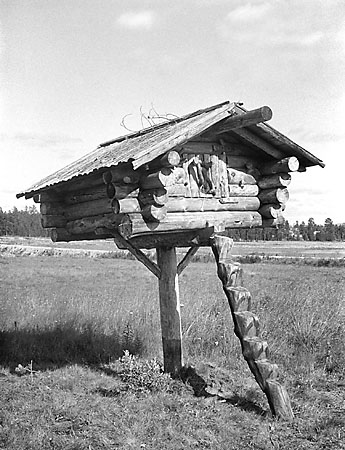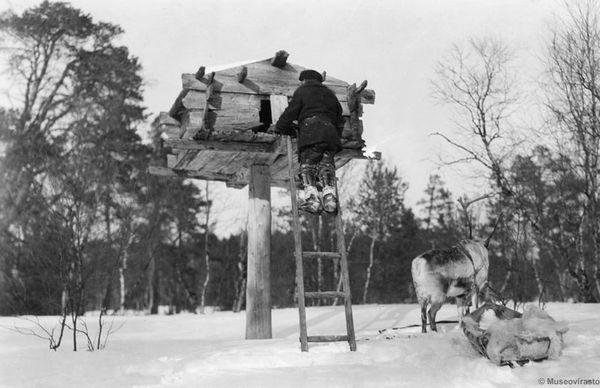Njalla, a small store house on the top of a wooden pole
Njalla (niliaitta)
Jutaavaa elämää viettävät saamelaiset tarvitsivat myös paikallaan pysyviä vakinaisia säilytystiloja, jonne he saattoivat säilöä syksyisin esim. porosta saatuja ruokatarpeita kevään varalle. Syksyisin porot olivat kesän jäljiltä parempikuntoisia ja niistä sai enemmän ravintoa kuin keväällä.
Yksi säilytyspaikoista oli pieni aitta, joka seisoi paksun korkean paalun varassa metsäneläinten ulottumattomissa. Pohjoissaamelaiset nimittävät aittaa sanalla njalla. Sanalla on vastineita miltei kaikissa saamelaiskielissä. Se on lainautunut myös suomen kieleen, lähinnä pohjoisiin murteisiin, jossa tunnetaan sana nili.
Saamelaiskielten sanalle on esitetty vastineita etäisistä sukukielistä mansista sekä samojedikielistä jurakista ja selkupista. Merkitykseltään esitetyt vastineet ovat melko lähellä saamelaisia sanoja: mansin sana tarkoittaa (lihan)kuivaustelinettä, jurakin sana varastona toimivaa suojakatosta ja selkupin sana tuohikoppaa, jossa lapset istuvat esim. matkoilla tulen ääressä. Obinugrilaisilla kansoilla onkin ollut vastaavanlaisia niliaittoja kuin saamelaisilla.
Saamelaissana saattaa kuulua yhteen puun kuoren irrottamista, nilomista merkitsevän verbin kanssa, joka pohjoissaamessa on njallat. Verbi tunnetaan miltei kaikissa saamelaiskielissä. Paalu, jonka varaan niliaitta on rakennettu, on yleensä kuorittu ja höylätty sileäksi, jotta ruokaa vainuavat eläimet eivät pääsisi kiipeämään sitä myöten ylös. Verbi njallat kuuluu vanhaan suomalais-ugrilaista perua olevaan sanaperheeseen, jolla on jäseniä aina hantissa asti. Suomenkielisiä vastineita ovat esimerkiksi nila ja niloa.
Sisällysluettelo: Elinkeinot ja liikkuminen
Njalla, a small store house on the top of a wooden pole
The nomadic reindeer-herding Saami needed fixed permanent storage places where in autumn they could leave for example the preserved foodstuffs they had obtained from the reindeer until the following spring. In autumn the reindeer were in a better condition after the summer, and thus they provided more sustenance than in spring.
One such storage place was a small covered cache placed out of the reach of animals on top of a stout, high pole. The North Saami word for this kind of storage place is njalla. There are corresponding forms in nearly all the Saami languages. It has also been borrowed in Finnish, mainly into the northern dialects, in the form nili.
Cognate forms to the Saami word have been proposed in distantly related languages like Mansi and the Samoyedic languages Yurak and Selkup. Semantically these correspondences are fairly close to the Saami word; the Mansi word means a drying rack (for meat), the Yurak word a storage shelter, and the Selkup word a bark pannier or frame in which children sat beside the fire during travels. Moreover, the Ob-Ugric peoples had similar storage places to those of the Saami.
The Saami word may be related to a verb which means to debark , the North Saami form of which is njallat. Corresponding forms of this verb are found in almost all the Saami languages. The pole on which the cache was constructed was usually debarked and scraped smooth so that animals that scented the food could not climb up it. The verb njallat belongs to an ancient Finno-Ugric word family, with cognates in distantly related languages like Khanty. Related forms in Finnish are nila phloem, inner bark and niloa to debark .
Table of contents: Living and household, clothing etc.

